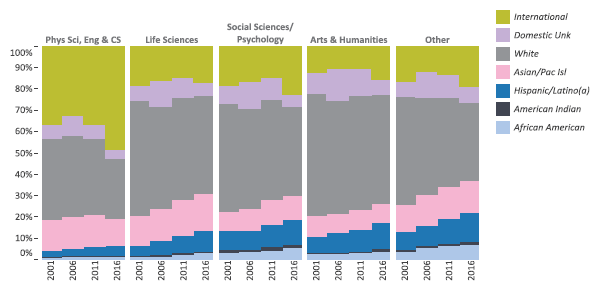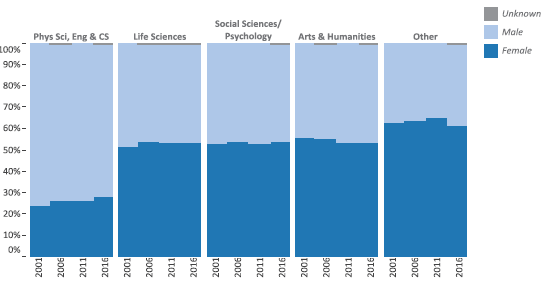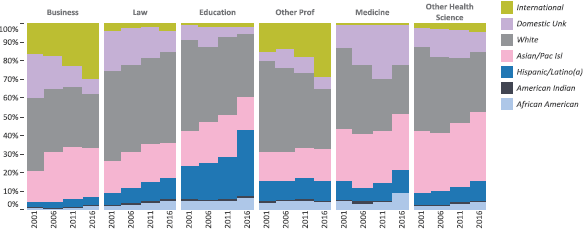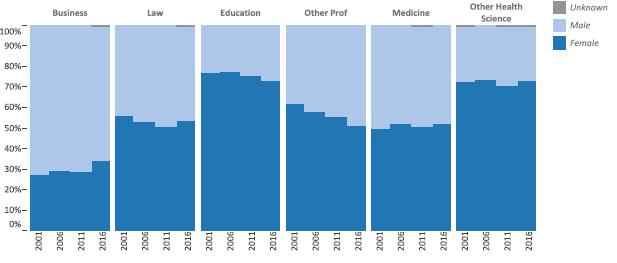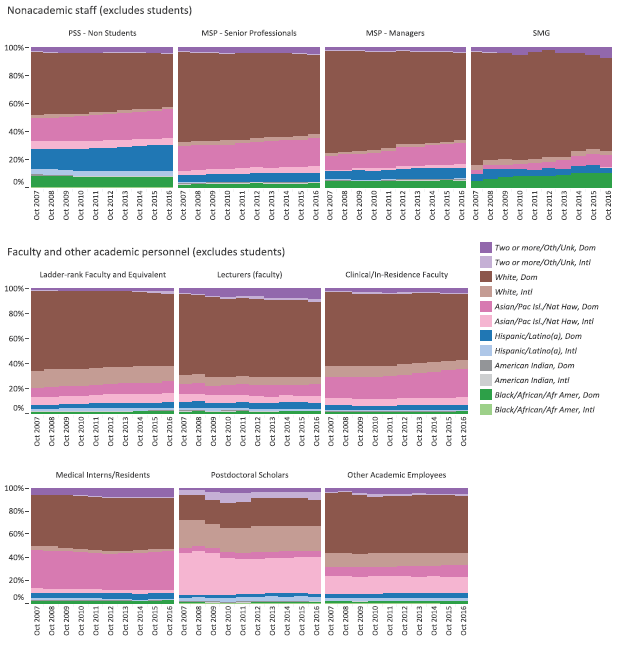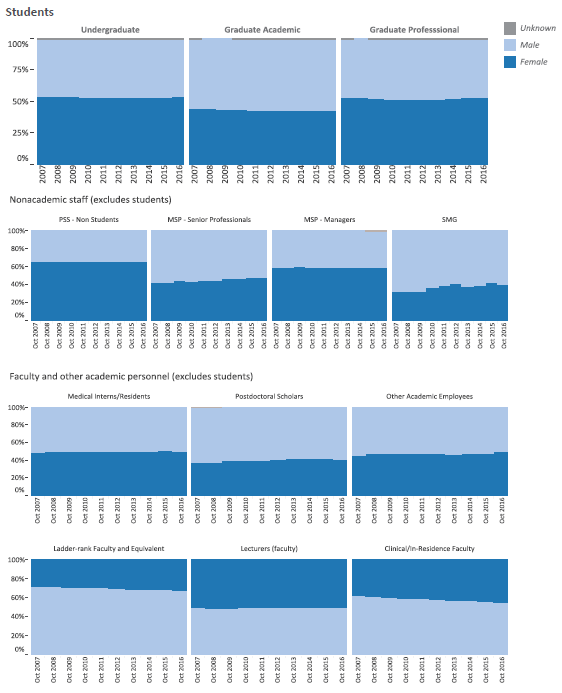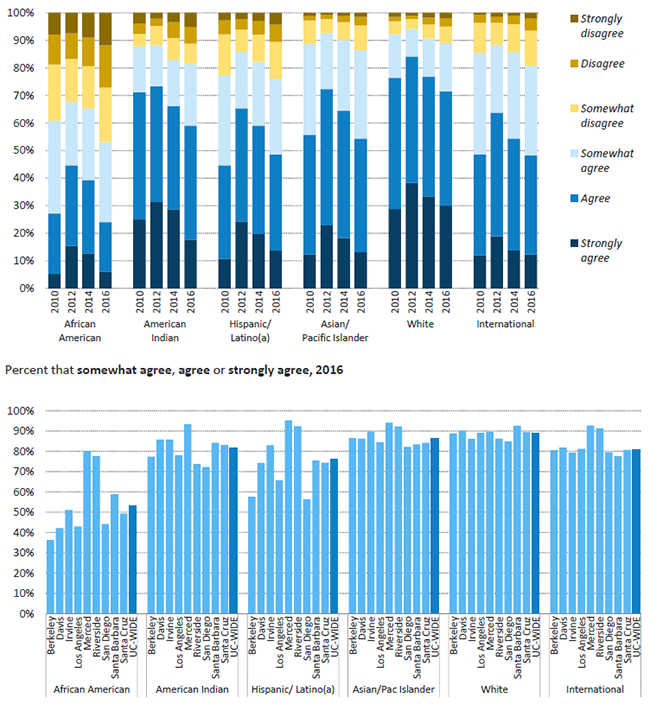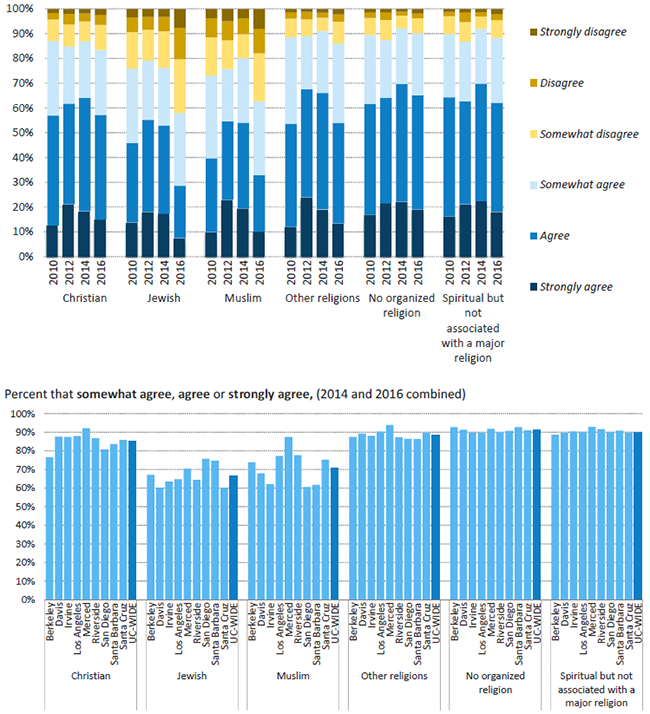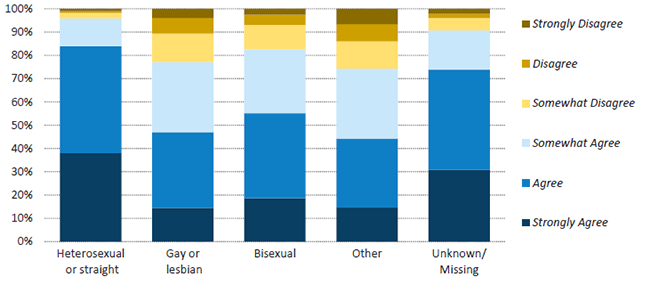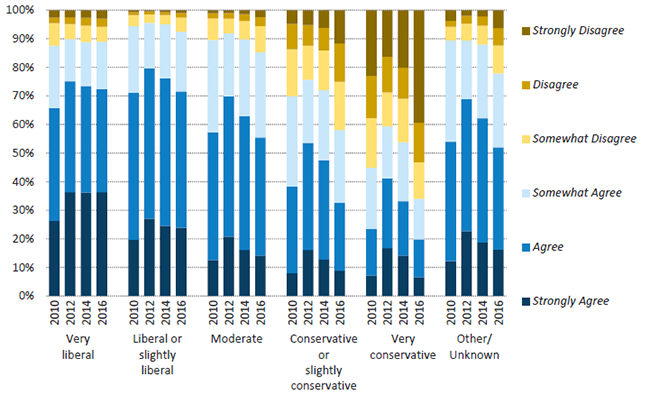Goals
The University of California is dedicated to fostering a community that provides leadership for constructive participation in a diverse, multicultural world. The University has a long history of supporting initiatives that foster an inclusive living, learning and working environment.
The University’s diversity goals are established in Regents Policy 4440: University of California Diversity Statement, which states, in part:
Because the core mission of the University of California is to serve the interests of the State of California, it must seek to achieve diversity among its student bodies and among its employees.
The State of California has a compelling interest in making sure that people from all backgrounds perceive that access to the University is possible for talented students, staff, and faculty from all groups.
Therefore, the University of California renews its commitment to the full realization of its historic promise to recognize and nurture merit, talent, and achievement by supporting diversity and equal opportunity in its education, services, and administration, as well as research and creative activity.
The University particularly acknowledges the acute need to remove barriers to the recruitment, retention, and advancement of talented students, faculty, and staff from historically excluded populations who are currently underrepresented.
Summary of findings
UC is making progress in several key areas related to diversity and inclusion. These include:
- A growing number of Hispanic/Latino(a) undergraduates
- Increasing undergraduate graduation rates across all racial/ethnic groups
- Increasing proportions of female ladder-rank faculty across all discipline groups and a slight increase in the percentage of Hispanic/Latino(a) faculty
- Slow but steady progress in the percentage of underrepresented graduate academic students
- An increasingly diverse career staff workforce
At the same time, however, challenges include:
- Low enrollment of African American and American Indian undergraduate students
- Low proportion of female and underrepresented faculty compared to availability pools in most disciplines (presented in Chapter 5 of this report)
- Issues of not feeling respected reported by undergraduates of historically underrepresented groups
- The graduation gap between underrepresented and White and Asian undergraduates (presented in Chapter 3 of this report)
Evaluating diversity
UC’s diversity is evaluated a variety of ways: current demographic characteristics and trends of its students, faculty and staff; policies and activities that promote equity and inclusion; and survey data that reveal perceptions of campus climate and respect.
The indicators in this chapter present an overview of trends for undergraduate, graduate academic and graduate professional students. This feeds into an overview of the University by race/ethnicity and gender.
Trend data illustrate growing proportions of underrepresented and international students in the undergraduate population. Over the last 15 years, the proportion of Hispanic/Latino(a) undergraduates has grown tremendously, reflecting the growing number of Hispanic/Latino(a) students in California and improved high school graduation rates. Five UC campuses (Irvine, Merced, Riverside, Santa Cruz and Santa Barbara) are designated by the federal government as Hispanic-Serving Institutions (HSIs). UC Davis, UCLA and UC San Diego are also emerging HSIs.
Among graduate academic students, underrepresented populations show steady increases across disciplines, with growth in international students generally in physical science and engineering. Female students are the majority in all disciplines except for physical science and engineering. Graduate professional degree programs show similar patterns for underrepresented and international students, with variation by discipline. Education programs have a larger proportion of underrepresented students, and business and other professional degree programs have growing international populations. The proportion of female students in graduate professional degree programs is trending slightly downward but remains around 50 percent or higher for all disciplines except business.
For staff, the proportions of nonwhite and female Managers and Senior Professional (MSP) and Senior Management Group (SMG) positions are smaller than their proportions in Professional and Support Staff (PSS) positions. The proportion of females among ladder-rank faculty is lower than proportions among other academic employees.
Surveying students about diversity on campus
This chapter presents responses to the UC Undergraduate Experience Survey (UCUES), given every two years to all undergraduates. The University’s goal is to ensure that all students are respected on campus, regardless of race/ethnicity, religious affiliation, gender, sexual orientation or political beliefs.
UCUES data show most undergraduates feel students of their race/ethnicity are respected on campus, but the proportion of African American respondents sharing this perspective is lower than other groups. Among religious identifications, Muslim and Jewish students are less likely to feel respected. LGBQ students also are less likely to feel respected. Students identifying as having conservative political beliefs are less likely to feel respected.
Diversity indicators elsewhere in this report
Graduation rates for entering freshmen and undergraduate transfers by race/ethnicity are presented in Chapter 3 — Undergraduate Student Success.
Indicators for new faculty hiring compared to national availability pools for underrepresented groups and women are presented in Chapter 5 — Faculty and Other Academic Employees.
Looking forward—diversity initiatives
Through its college preparation outreach programs, UC devotes considerable resources to offering college preparation support to more than 100,000 K–12 and community college students annually. This effort results in a greater number of students who are prepared and qualified for UC. Of the high schools served by UC, roughly 70 percent have consistently been among the lowest-performing schools in the state. Participants in these programs have higher rates of enrollment in California public college segments, and those who are accepted to UC enroll at higher rates than their peers.
UC’s college preparation programs remove participants’ obstacles to attending UC, encouraging them to apply and enroll at UC at higher rates than those overall for California high school graduates. The most recent data for fall 2015 show the enrollee yield — the ratio of students admitted to UC who enroll — for participants in UC academic preparation programs is higher, at 61.7 percent, than for all California high school graduates at 53.2 percent.
African American participants in a UC college preparation program were also more likely to enroll at a UC campus than were their peers who did not participate (58 percent compared to 50 percent).
In addition to funding UC’s college preparation programs, the 2016–17 state budget for UC included $20 million in one-time funding for support services for “low-income students and students from underrepresented minority groups,” including students who were enrolled in high schools designated by the California Department of Education as eligible for supplemental funding under the Local Control Funding Formula (LCFF) because of their populations of low-income or educationally disadvantaged students. UC campuses are using this funding for two primary purposes: to increase the application, admission and enrollment of students from these schools; and to provide academic support services to enrolled students, focusing on those who are low-income, first-generation-college or otherwise educationally disadvantaged. Outcomes from this initiative will be reported in fall 2017.
In October 2015, the Office of the President launched the President’s Diversity Pipeline Initiative (DPI) to expand the academic pipeline to the University of California for undergraduate students, graduate students and faculty who remain persistently underrepresented at UC. The Diversity Pipeline Initiative builds on existing University resources — admissions policies and practices, academic preparation (outreach) programs and community partnerships, among others. Outcomes from the first year of the DPI include:
- Admissions of African American students in fall 2016 were up by 30.6 percent from fall 2015.
- 44 percent of fall 2017 California freshman applicants were from underrepresented minority (URM) backgrounds.
- 36.4 percent of new California freshmen in fall 2016 were from URM backgrounds.
- UC college-prep programs saw a 12.7 percent increase in African American student enrollment from 2012–13 to 2015–16.
The UC-HBCU Initiative improves diversity and strengthens graduate programs by investing in relationships between UC campuses and Historically Black Colleges and Universities (HBCUs). Since its inaugural year (2012), more than 315 HBCU scholars have participated in the program, which offers faculty-led summer research opportunities and year-round mentoring. Twenty-seven Ph.D. students and two M.A. students are currently enrolled at UC, and three M.A. students have already graduated from UC as a direct result of the program.
The President’s Postdoctoral Fellowship Program (PPFP) is a keystone program at the University of California that supports diversification of UC faculty through financial support and career development training for postdoctoral scholars that show promise to be successful faculty in the UC system. Fellows have a demonstrated record of commitment to diversity in their research, teaching and/or outreach. The fellowship is extremely competitive, selecting the top 3 percent of applicants. Since the 2013–14 academic year there have been over 500 applicants to the program annually, this year reaching over 850. The program selects approximately 20 fellows annually. The President’s Postdoctoral Fellowship Program and the Chancellors’ Fellowship Programs have accounted for 11.5 percent of new underrepresented minority faculty hired at UC in the last ten years. At present, 165 PPFP fellows have been hired into UC tenure-track positions since 2004.
For more information
Here are links to key products in the UC Information Center in each area:

